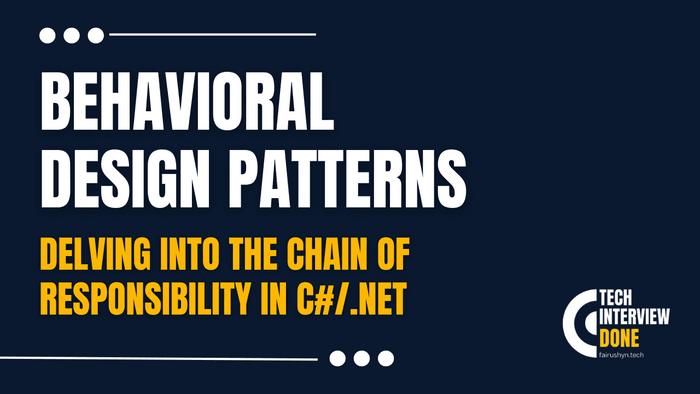Delving into the Chain of Responsibility in C#/.NET
3 min read · — #design-patterns#structrural-patterns#chain-of-responsibility
Introduction
Imagine stepping into a realm where complexity is unraveled with elegance and flexibility. In the vast universe of software engineering, design patterns emerge as beacons of strategy, guiding us through the architectural maze with principles that withstand the test of time and change. Among these patterns, the Chain of Responsibility stands out as a paradigm of decentralized decision-making, a technique that not only streamlines processes but also encapsulates the very essence of adaptable and maintainable code. This post ventures deep into the heart of the Chain of Responsibility pattern, specifically tailored for the discerning minds that thrive on the challenges and intricacies of software design in the C#/.NET ecosystem.
The Essence of Chain of Responsibility
The Chain of Responsibility pattern is a behavioral design pattern that allows an object to pass the request along a chain of handlers. Upon receiving a request, each handler decides either to process it or to pass it to the next handler in the chain. This pattern decouples the sender of a request from its receivers, giving more than one object the opportunity to handle the request. The chain's flexibility allows for dynamic addition or removal of handlers, making this pattern incredibly versatile in managing workflows, operations, or command sequences.
Real-World Scenario: A Practical Dive
Consider a customer support system where a request (ticket) can be solved by different departments (handlers), such as Technical Support, Billing, or Customer Relations. The goal is to resolve the ticket efficiently, ensuring it reaches the appropriate department without creating a rigid, hard-coded pathway.
Implementing the Chain
To bring this scenario to life in C#, start by defining an abstract handler that represents each department:
public abstract class SupportHandler
{
protected SupportHandler nextHandler;
public void SetNextHandler(SupportHandler nextHandler)
{
this.nextHandler = nextHandler;
}
public abstract void HandleRequest(SupportTicket ticket);
}Next, concrete handlers implement this base class, providing specific handling capabilities:
public class TechnicalSupportHandler : SupportHandler
{
public override void HandleRequest(SupportTicket ticket)
{
if (ticket.Type == TicketType.Technical)
{
Console.WriteLine("Handled by Technical Support");
// Handle the ticket
}
else if (nextHandler != null)
{
nextHandler.HandleRequest(ticket);
}
}
}
public class BillingSupportHandler : SupportHandler
{
public override void HandleRequest(SupportTicket ticket)
{
if (ticket.Type == TicketType.Billing)
{
Console.WriteLine("Handled by Billing Support");
// Handle the ticket
}
else if (nextHandler != null)
{
nextHandler.HandleRequest(ticket);
}
}
}
// Additional handlers can be defined similarlyFinally, the chain is constructed by linking the handlers:
var techSupport = new TechnicalSupportHandler();
var billingSupport = new BillingSupportHandler();
techSupport.SetNextHandler(billingSupport);
// Additional handlers can be linked here
var ticket = new SupportTicket(TicketType.Technical);
techSupport.HandleRequest(ticket);This implementation illustrates the power of the Chain of Responsibility pattern: it promotes loose coupling, enhances flexibility, and fosters a cleaner separation of concerns.
Advantages and Considerations
- Decoupling: The sender of a request is decoupled from the receivers. This separation fosters flexibility in changing the chain dynamically.
- Flexibility: Handlers can be added or changed without altering the core logic of the application, making the system more adaptable to evolving requirements.
- Simplicity: It simplifies your code by distributing responsibilities among classes, each handling its part.
However, careful attention is needed to avoid creating an overly long or problematic chain that could impact performance or result in unresolved requests.
Conclusion
The Chain of Responsibility pattern is a testament to the beauty of decentralized decision-making in software architecture. By embracing this pattern, developers wield the power to craft systems that are not only robust and adaptable but also elegantly organized. As we journey through the landscapes of C# and .NET, let the Chain of Responsibility be your ally in designing solutions that stand the test of complexity and change. Through practical application and continuous exploration, the pattern's potential is limitless, limited only by the bounds of imagination and the challenges that await in the ever-evolving world of software engineering.
